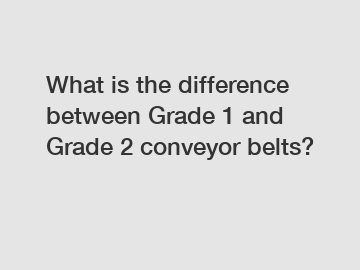What is the difference between Grade 1 and Grade 2 conveyor belts?
Conveyor belts play a crucial role in numerous industries, aiding the smooth and efficient movement of goods and materials. However, not all conveyor belts are created equal. In fact, they are classified into various grades based on their specific attributes and capabilities. In this blog, we will explore the key differences between Grade 1 and Grade 2 conveyor belts to help you make informed decisions when choosing the right conveyor belt for your application.
Grade 1 Conveyor Belts: Unyielding Strength and Durability.
Grade 1 conveyor belts are renowned for their exceptional strength and durability. Designed to withstand the harsh requirements of heavy-duty industries, these belts are highly resistant to tearing, impact, and abrasion. They are commonly utilized in mining, construction, and recycling operations where the materials being transported have significant weight and are subjected to rough handling.

One of the primary advantages of Grade 1 conveyor belts is their exceptional tensile strength. These belts are manufactured using multiple layers of robust fabric, bonded together with high-performance rubber compounds. This construction ensures optimal tensile strength, which enables Grade 1 belts to handle heavy loads without stretching or elongation, even under extreme operating conditions.
Furthermore, Grade 1 conveyor belts are equipped with top-notch cover compounds to enhance their resistance to wear and tear. These cover compounds are specifically designed to withstand the abrasive impact of sharp-edged materials, ensuring prolonged belt lifespan and reduced maintenance costs.
Grade 2 Conveyor Belts: Versatile Resilience and Flexibility.
While Grade 2 conveyor belts may not possess the same extreme robustness as their Grade 1 counterparts, they excel in terms of versatility and flexibility. They are suitable for a wide range of applications in medium-duty industries such as agriculture, food processing, and packaging.
Grade 2 conveyor belts strike a balance between strength and flexibility, making them ideal for conveying lighter to moderate loads. Although they may not withstand the heavy demands of industries dealing with bulky materials, they offer sufficient durability for general-purpose applications. These belts are commonly used in industries where goods are lighter, movements are less aggressive, and impact forces are lower.
Moreover, Grade 2 conveyor belts often feature different fabric compositions, thinner layers, and specially formulated cover compounds. These design variations enable them to exhibit greater flexibility, allowing for enhanced adaptability to the dynamic needs of the industry. They offer superior resistance to minor impacts and elongation, ensuring reliable performance throughout a variety of conveying tasks.
Choosing the Right Conveyor Belt for Your Application.
When it comes to choosing between Grade 1 and Grade 2 conveyor belts, several factors should influence your decision:
1. Application-specific Requirements: Evaluate the nature of your materials, anticipated load capacity, and impact force. If you handle heavy materials or operate in demanding industries, Grade 1 belts provide the strength and durability required to meet the rigorous demands. For lighter loads, moderate impacts, and versatile operations, Grade 2 belts are more suitable.
2. Cost Consideration: Grade 1 conveyor belts are typically more expensive than Grade 2 belts due to their advanced construction and higher-end materials. Consider your budget and the long-term maintenance costs when making a decision.
3. Longevity and Maintenance: Grade 1 belts boast a longer lifespan and require less frequent maintenance due to their superior resistance to wear and tear. However, Grade 2 belts can still offer satisfactory durability if properly cared for.
Conclusion.
In summary, the distinction between Grade 1 and Grade 2 conveyor belts lies mainly in their strength, durability, and application suitability. Grade 1 belts are engineered for heavy-duty applications, offering exceptional tensile strength and resistance to abrasion and impact. On the other hand, Grade 2 belts provide versatility and flexibility, catering to medium-duty operations.
Carefully assess the specific requirements of your industry, including material characteristics, load capacity, and impact forces, to determine which grade of conveyor belt aligns with your needs. Remember to consider the trade-off between strength and flexibility, the related costs, and the overall lifespan of the belt.
By selecting the appropriate grade of conveyor belt, you can enhance operational efficiency, reduce maintenance costs, and ensure reliable material handling in your industry.
For more information, please visit Aoyuan Rubber Machine Belt, Aoyuan Rubber Machine Belt, Aoyuan Rubber Machine Belt.


